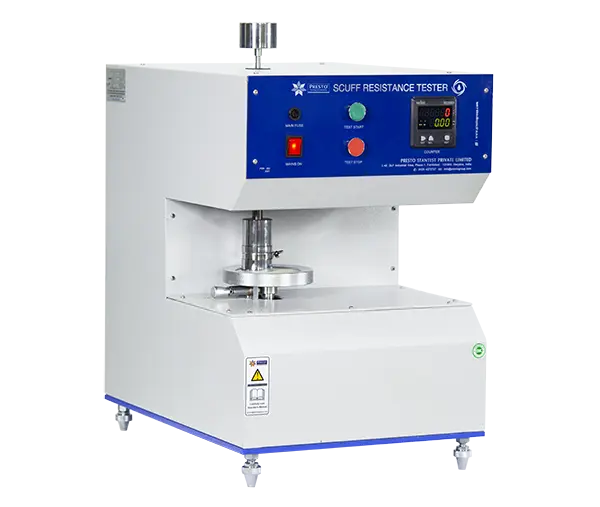In the fast-paced manufacturing and packaging industries of today, surface quality and print durability are two key indicators of product quality. Labels, printed packages and decorative surfaces need to be visually appealing, but also need to resist the effects of handling, shipping, and storage, without sacrificing their visual quality. This is where a scuff tester is an essential testing device. It ensures that printed surfaces retain their clarity and the finished substrate surface from mechanical abrasion or repetitive friction.
A scuff tester will assess the resistance of printed substrates, coatings and surfaces to scuffing, rubbing or abrasion. The testing replicates real-world conditions in which two surfaces will come into contact repeatedly, such as stacking, shipping or storage. The data generated allows manufacturers to assess the durability of inks, coatings and substrates used in packaging, and to ensure that substrates maintain their visual quality and legibility throughout the shelf life.
Why Surface Testing Matters in Modern Manufacturing
In sectors such as packaging, printing, and labeling, product appearance plays a vital role in attracting customers and representing brand quality. Any visible damage, fading, or scuff marks can negatively affect a brand’s reputation. That’s why manufacturers invest in reliable testing instruments to ensure that their printed surfaces withstand real-life challenges.
Indonesia’s growing manufacturing sector, particularly in packaging, food and beverage, cosmetics, and pharmaceuticals, demands consistent quality and durability in printed materials. A scuff tester in Indonesia helps local manufacturers meet international standards by verifying that their labels and prints can resist wear during distribution and storage. This improves customer satisfaction and helps brands maintain their image even under demanding environmental conditions.
How a Scuff Tester Works
The operation of a scuff tester is based on the principle of controlled rubbing between two printed surfaces under a specified load. The test samples are mounted face-to-face, and the machine applies rotational or linear motion to simulate real-life scuffing. After a defined period, the degree of damage, fading, or wear is analyzed visually or instrumentally.
This test is particularly useful for evaluating printed cartons, flexible packaging films, labels, and laminated surfaces. The results help determine the suitability of inks, coatings, and substrates for specific applications. For industries that rely heavily on packaging aesthetics, this testing process ensures consistent quality and long-lasting appeal.
Key Benefits of Using a Scuff Tester
-
Enhanced Product Presentation: By ensuring that printed surfaces resist rubbing and abrasion, manufacturers can maintain the visual appeal of their products, even after extended handling.
-
Reduced Rejection Rates: Consistent surface quality reduces the chances of damaged or faded packaging being rejected by retailers or consumers.
-
Improved Material Selection: Test results allow manufacturers to choose the best combinations of inks, coatings, and substrates for durable print performance.
-
Compliance with International Standards: Many industries require testing as part of ISO or ASTM compliance, making the scuff tester essential for quality certification.
-
Brand Reputation Protection: A product’s outer appearance is often its first impression—ensuring its durability enhances brand reliability and trust.
Industries That Benefit from Scuff Testing
Scuff testing is essential across a wide range of industries. In the packaging sector, it ensures that boxes, labels, and pouches remain intact and readable throughout the supply chain. The printing industry uses it to validate ink formulations and surface coatings for long-term durability. Pharmaceutical manufacturers rely on scuff testing to ensure that crucial label information remains legible, even after frequent handling. Similarly, cosmetic and food packaging industries use this testing to maintain aesthetic appeal and protect branding.
Choosing the Right Scuff Tester
When selecting a scuff tester, manufacturers should consider several important features:
-
Adjustable Load and Speed: Flexibility to vary test parameters ensures the equipment can simulate different real-world conditions.
-
Consistent and Repeatable Results: Precision in testing is crucial for accurate comparison between materials or designs.
-
User-Friendly Interface: Easy operation allows technicians to conduct tests efficiently without complex training.
-
Durability and Maintenance: A sturdy, low-maintenance design ensures long-term use and consistent performance.
A good scuff tester should meet global testing standards such as ASTM D5264 or BS 3110, ensuring that the results are valid across international markets.
Best Practices for Using a Scuff Tester
To ensure reliable results, the scuff tester should be used under controlled environmental conditions, as temperature and humidity can influence results. Test samples should be properly mounted, and surfaces must be clean before testing. Regular calibration and maintenance of the machine are also critical for maintaining accuracy.
Recording and analyzing results over multiple batches helps manufacturers identify trends, improve processes, and enhance the durability of their materials. When used effectively, a scuff tester becomes a valuable tool for quality improvement and process optimization.
The Role of Scuff Testers in Sustainability
Beyond aesthetics and durability, surface testing contributes to sustainability efforts. By identifying materials and coatings that perform better under stress, manufacturers can reduce waste caused by damaged packaging. Stronger and more durable materials often require fewer replacements and less rework, which lowers production costs and environmental impact.
Conclusion
For manufacturers in Indonesia, investing in a reliable scuff testing solution is a step toward improved quality assurance and enhanced product presentation. The scuff tester in Indonesia helps industries validate their material durability, reduce defects, and maintain a strong brand presence in both local and international markets. With growing demand for high-quality packaging and printed materials, scuff testing has become an essential practice for achieving long-term business success.
About Presto Instruments
Presto Instruments is a trusted name in the field of quality testing equipment. With years of experience and innovation, the company provides advanced scuff testers designed for precision, durability, and ease of use. Their instruments comply with international testing standards and deliver accurate, repeatable results across various industries. Backed by excellent customer support and technical expertise, Presto Instruments continues to empower manufacturers with reliable testing solutions that enhance product quality and operational efficiency.




